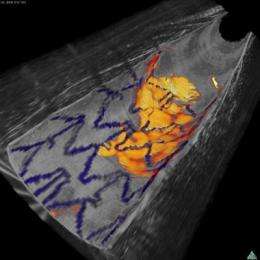Combined arterial imaging technology reveals both structural and metabolic details

A new device that combines two microimaging technologies can reveal both the detailed anatomy of arterial linings and biological activities that, in coronary arteries, could indicate the risk of heart attacks or the formation of clots in arterial stents. In their report receiving early online release in Nature Medicine, Massachusetts General Hospital (MGH) investigators describe using an intra-arterial catheter combining both optical frequency-domain imaging (OFDI) and near-infrared fluorescence (NIRF) imaging to obtain simultaneous structural and molecular images of internal arterial surfaces in rabbits.
"The ability to measure both microstructural and molecular information from the same location in the artery wall could provide a much better diagnostic tool for assessing vascular pathology, information that is highly relevant for diagnosing coronary artery disease, vulnerable plaque and evaluating stent healing," says Gary Tearney, MD, PhD, of the Wellman Center for Photomedicine and the MGH Pathology Department, co-senior author of the article.
Developed at the Wellman Center, OFDI utilizes a fiberoptic probe with a constantly rotating laser tip to create detailed molecular images of interior surfaces such as arterial walls. While OFDI can be used to guide procedures like coronary artery angioplasty and to confirm the correct positioning of metal stents inserted to keep cleared arteries open, its ability to determine important details of stent healing is limited. Properly healed stents become covered with endothelium, the same tissue that normally coats the arterial surface; but stents can become coated with the clot-inducing protein fibrin, which may put patients at risk for stent thrombosis – a clot that blocks bloodflow through the stent – and OFDI cannot determine the molecular composition of tissue covering a stent.
Intravascular NIRF technology was developed in the MGH Cardiovascular Research Center (CVRC), in collaboration with colleagues at the Technical University of Munich, and uses special imaging agents to detect cells and molecules involved in vascular processes like clotting and inflammation. Recognizing the potential advantage of combining both technologies, the Wellman researchers worked with the MGH-CVRC team, led by Farouc Jaffer, MD, PhD, of the MGH Heart Center to develop an integrated OFDI-NIRF imaging system incorporated in the same intravascular probe used for OFDI alone.
The team first confirmed that the system could provide detailed structural images of a stent implanted in a cadaveric human coronary artery and could accurately identify the presence of fibrin on the stent. In a series of experiments in living rabbits, the OFDI-NIRF system was able to detect fibrin on implanted stents – including areas where it was not detected by OFDI alone – and to identify the presence of both atherosclerotic plaques and enzymatic activity associated with inflammation and plaque rupture. The enzyme signal detected by NIRF was not uniform throughout the imaged plaques, indicating biological differences that could be relevant to prognosis and treatment planning.
"At present we are not able to predict which patients may develop stent thrombosis, but integrated OFDI-NIRF can assess many key factors linked to the risk of clot formation," says Jaffer, co-senior author of the Nature Medicine report. "If OFDI-NIRF is validated in clinical studies, patients at risk for stent thrombosis could undergo a 'stent checkup' to determine how well the stent is healing. Patients with unhealed stents could be advised to take or continue taking specific anti-clotting medications. Patients with well-healed stents, on the other hand, could potentially discontinue anti-clotting medications, which can cause excess bleeding." Clinical adoption of the integrated technology will require FDA approval of the molecular contrast agents used in NIRF.

















